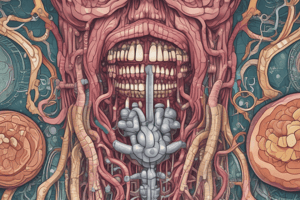Podcast
Questions and Answers
Which salivary gland produces the highest percentage of saliva?
Which salivary gland produces the highest percentage of saliva?
- Submandibular gland (correct)
- Parotid gland
- Minor salivary glands
- Sublingual gland
What is the typical range for the amount of saliva produced daily by an adult?
What is the typical range for the amount of saliva produced daily by an adult?
- 0.5 - 1 liter
- 2 - 2.5 liters
- 1 - 1.5 liters (correct)
- 3 - 3.5 liters
Which of the following is NOT a characteristic of saliva?
Which of the following is NOT a characteristic of saliva?
- Colorless
- Produced by salivary glands
- Slightly sticky
- Odorless (correct)
What is the approximate percentage of saliva produced by the parotid gland?
What is the approximate percentage of saliva produced by the parotid gland?
Saliva can be described as either serous or mucous. What does the term 'mucous' indicate?
Saliva can be described as either serous or mucous. What does the term 'mucous' indicate?
Flashcards
Saliva
Saliva
A colorless, slightly sticky solution produced by salivary glands, consisting of various components.
Organic components of saliva
Organic components of saliva
Includes enzymes, antibodies, and proteins that aid in digestion and protect oral health.
Inorganic components of saliva
Inorganic components of saliva
Mainly consists of water, electrolytes, and minerals like calcium and phosphate.
Major salivary glands
Major salivary glands
Signup and view all the flashcards
Salivation mechanism
Salivation mechanism
Signup and view all the flashcards
Study Notes
Saliva and Salivation
- Saliva is a colorless, slightly sticky solution produced by salivary glands.
- It exists in serous or mucous consistency.
- Daily saliva production is between 1-1.5 liters.
- The major salivary glands (submandibular, parotid, sublingual, and minor salivary) produce varying amounts of saliva, contributing different percentages to the total volume.
GDC ILOS
- 1.1.5: Describe relevant and appropriate dental, oral, craniofacial, and general anatomy, explaining their application to patient management.
- 1.1.6: Describe relevant and appropriate physiology, explaining its application to patient management.
Aim
- Gain an overview of saliva, its function, and the process of salivation.
Learning Outcomes
- 1: List organic and inorganic components of saliva, describing their function.
- 2: Describe the functions of saliva.
- 3: Describe the mechanism of salivation.
- 4: Outline factors impacting salivary flow.
Saliva Composition
- Saliva is mostly water (99%).
- The remaining 1% comprises organic and inorganic substances.
- The composition can be difficult to assess due to variations in saliva produced by different stimuli.
Saliva Components
- Proteins: Several hundred, many with antibacterial properties. Examples include mucin (gives viscosity) and enzymes (like amylase and lysozyme).
- Immunoglobulins (Ig's): IgA, IgG, and IgM help remove bacteria through agglutination.
- Enzymes: Lysozyme destroys bacteria by lysis, lactoferrin inhibits bacterial growth, lactoperoxidase inhibits bacterial metabolism, and amylase breaks down cooked starches.
- Waste Products: Urea neutralizes acids; ammonia raises pH.
- Cells: Desquamated epithelial cells, white blood cells, and commensal bacterial cells.
- Food Debris: Food particles can be present in saliva.
- Hormones: Estrogen and progesterone.
- Inorganic Components (Ions): Includes calcium phosphate, sodium, potassium, magnesium, chloride, fluoride (remineralization, anti-bacterial), bicarbonate (buffer), sulfate, and hydrogen.
- Gas Components: Oxygen and nitrogen; carbon dioxide may be linked to calculus formation.
Saliva Functions
- Protective: Glycoproteins help lubricate and waterproof the oral cavity; aid speech; and prevent mucosa cracking and bacteria invasion. Creates a barrier against acid attacks. Serous saliva cleanses and removes food/bacterial debris.
- Buffering: Ions maintain pH, neutralizing acids and alkalis, and preventing bacterial colonization. Higher bicarbonate levels appear during higher salivary flow.
- Digestion: Salivary amylase breaks down starch and helps form the food bolus.
- Taste: Taste is only detected when substances are in solution in the mouth.
Saliva in Dentistry
- Saliva is important for cross-infection control because it can transmit viruses (e.g., COVID-19, Hep B, Hep C, Herpes simplex, Epstein-Barr virus, Tuberculosis)
- Saliva composition influences caries incidence and calculus formation.
- Saliva viscosity is important to the formation of the salivary pellicle, which protects against acid but facilitates plaque adherence.
- Saliva can buffer acid levels (ionic see-saw) within the oral cavity; fluctuating pH can affect enamel demineralization and remineralization.
Mechanism of Salivation
- Saliva production is a reflex stimulated by sensory inputs (sight, smell, taste).
- It's also controlled by the sympathetic and parasympathetic nervous systems.
- Sympathetic stimulation reduces flow (e.g., dry mouth in stress).
- Parasympathetic stimulation increases flow (e.g., mouth watering at food).
Salivary Flow Factors
- Factors that increase flow: mastication, irritants, gingival conditions, hunger, smell/sight of food, teething in babies.
- Factors that reduce flow: drugs, diabetes, alcohol, fear, radiotherapy, and surgery.
Hypersalivation and Xerostomia
- Hypersalivation: excessive saliva production; numerous medical conditions can cause it, including some medications and disorders.
- Xerostomia: dry mouth due to a reduction or absence of saliva; numerous medical conditions can cause it, including some medications and disorders.
Additional Notes
- Saliva composition and flow vary significantly, impacting oral health.
- Patients with impaired saliva flow have an increased risk of dental diseases, requiring adjusted patient management.
Studying That Suits You
Use AI to generate personalized quizzes and flashcards to suit your learning preferences.




